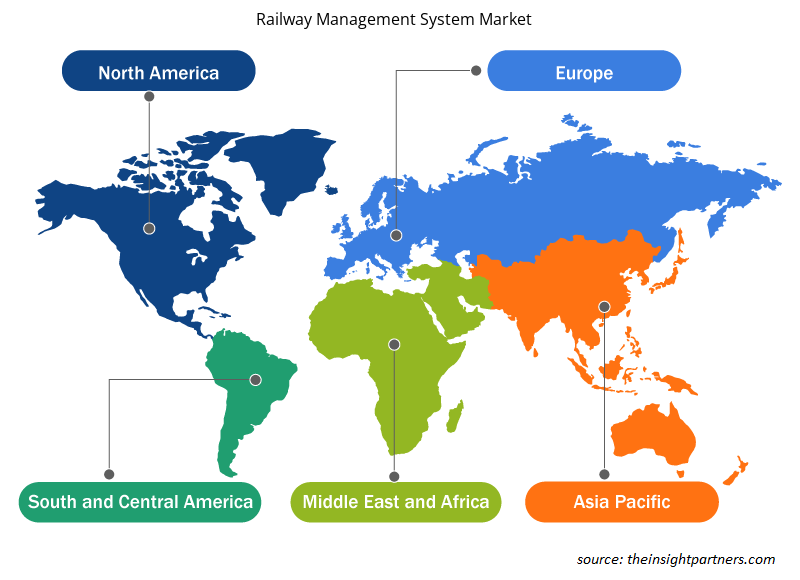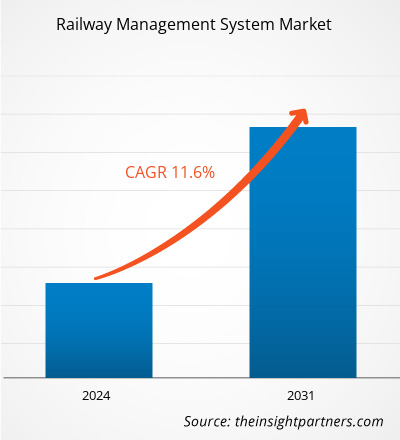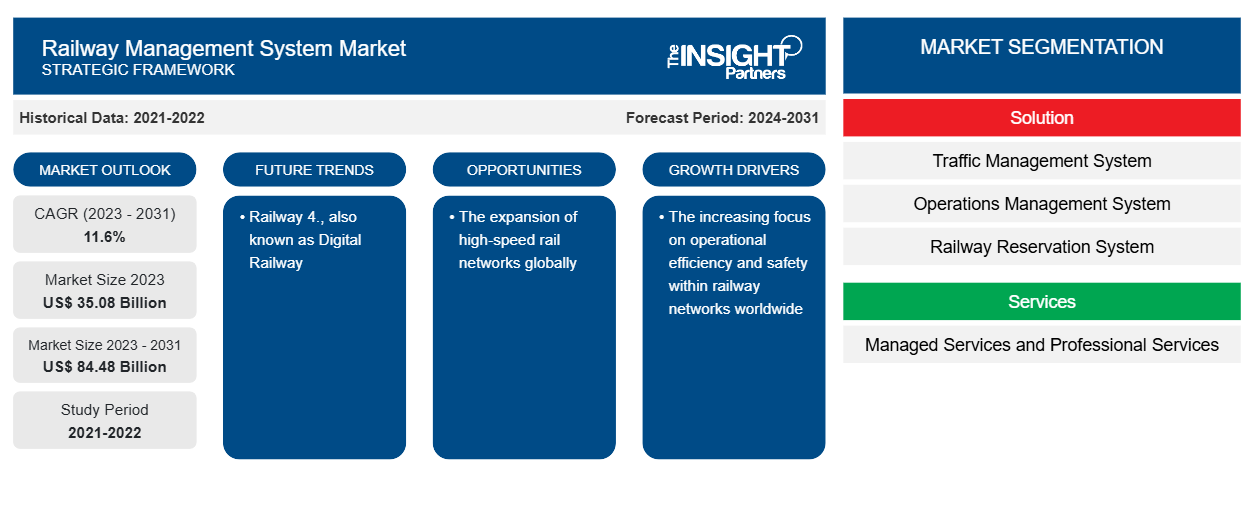من المتوقع أن يصل حجم سوق نظام إدارة السكك الحديدية إلى 84.48 مليار دولار أمريكي بحلول عام 2031 من 35.08 مليار دولار أمريكي في عام 2023. ومن المتوقع أن يسجل السوق معدل نمو سنوي مركب بنسبة 11.6٪ في الفترة 2023-2031. ومن المرجح أن تظل السكك الحديدية 4.0، المعروفة أيضًا باسم السكك الحديدية الرقمية، من أهم اتجاهات سوق نظام إدارة السكك الحديدية.
تحليل سوق نظام إدارة السكك الحديدية
ينمو سوق أنظمة إدارة السكك الحديدية من خلال اتجاهات مختلفة في تطوير البنية التحتية وتكنولوجيا النقل. تركز هذه الأنظمة على الكفاءة التشغيلية وتعزيز السلامة وتجربة الركاب على ميزات مثل المراقبة في الوقت الفعلي والصيانة التنبؤية. هناك العديد من التقنيات التي تدفع السوق بما في ذلك الذكاء الاصطناعي وإنترنت الأشياء والحوسبة السحابية، والتي تمكن من التحسين عن بعد وإدارة عمليات السكك الحديدية. بشكل عام، ينمو سوق أنظمة إدارة السكك الحديدية ويتوسع عالميًا، مدفوعًا بضرورة تحسين كفاءة السكك الحديدية وسلامتها واستدامتها.
نظرة عامة على سوق أنظمة إدارة السكك الحديدية
يشتمل نظام إدارة السكك الحديدية على العديد من العمليات والتقنيات لإدارة شبكات السكك الحديدية وتشغيلها بكفاءة. ويشمل مكونات مثل إدارة الشحن وأنظمة التذاكر ومعلومات الركاب وجدولة القطارات وجدولة الصيانة ومراقبة السلامة. ويستخدم النظام تقنيات متقدمة، مثل نظام تحديد المواقع العالمي (GPS) وشبكات الاتصالات وأجهزة استشعار إنترنت الأشياء لتمكين تحسين تخطيط المسار وضمان السلامة وتتبع القطارات في الوقت الفعلي. ويتم تحسين خدمات الركاب من خلال حجز المقاعد وحجز التذاكر عبر الإنترنت والتحديثات في الوقت الفعلي لجداول القطارات. وعلاوة على ذلك، يتم ترشيد أنشطة الصيانة وتقليل وقت التوقف وتحسين الكفاءة التشغيلية الإجمالية باستخدام تقنيات الصيانة التنبؤية.
قم بتخصيص هذا التقرير ليناسب متطلباتك
ستحصل على تخصيص لأي تقرير - مجانًا - بما في ذلك أجزاء من هذا التقرير، أو تحليل على مستوى الدولة، وحزمة بيانات Excel، بالإضافة إلى الاستفادة من العروض والخصومات الرائعة للشركات الناشئة والجامعات
-
احصل على أهم اتجاهات السوق الرئيسية لهذا التقرير.ستتضمن هذه العينة المجانية تحليلاً للبيانات، بدءًا من اتجاهات السوق وحتى التقديرات والتوقعات.
محركات وفرص سوق نظام إدارة السكك الحديدية
التركيز المتزايد على الكفاءة التشغيلية والسلامة داخل شبكات السكك الحديدية في جميع أنحاء العالم
مع تزايد أحجام الركاب والبضائع، يتجه مشغلو السكك الحديدية إلى أنظمة إدارة متقدمة لتحسين جدولة القطارات وصيانة المسارات والأداء العام للشبكة. تستفيد هذه الأنظمة من تقنيات مثل أجهزة استشعار إنترنت الأشياء والتحليلات التنبؤية والمراقبة في الوقت الفعلي لتعزيز السلامة وتقليل التأخيرات وتقليل التكاليف التشغيلية. من خلال تحسين الكفاءة والموثوقية، تساعد أنظمة إدارة السكك الحديدية في تلبية توقعات العملاء المتزايدة والمعايير التنظيمية.
توسع شبكات السكك الحديدية عالية السرعة على مستوى العالم
تستثمر العديد من البلدان في تحديث البنية التحتية للسكك الحديدية لدعم القطارات عالية السرعة، مما يوفر خيارات نقل أسرع وأكثر استدامة. يخلق هذا الاتجاه طلبًا كبيرًا على حلول إدارة السكك الحديدية المتقدمة القادرة على إدارة العمليات المعقدة بسرعات أعلى وضمان الاتصال السلس عبر شبكات السكك الحديدية المختلفة. مع استمرار توسع مشاريع السكك الحديدية عالية السرعة، فإن سوق أنظمة إدارة السكك الحديدية المبتكرة على استعداد لنمو كبير. وبالتالي، من المتوقع أن يقدم توسع شبكات السكك الحديدية عالية السرعة على مستوى العالم فرصًا جديدة للاعبين في سوق أنظمة إدارة السكك الحديدية خلال فترة التنبؤ.
تقرير تحليل تجزئة سوق نظام إدارة السكك الحديدية
إن القطاعات الرئيسية التي ساهمت في استخلاص تحليل سوق نظام إدارة السكك الحديدية هي نوع الحل والنشر.
- بناءً على الحل، يتم تقسيم سوق نظام إدارة السكك الحديدية إلى نظام إدارة المرور، ونظام إدارة العمليات، ونظام حجز السكك الحديدية، ونظام معلومات الركاب، ونظام إدارة الصيانة، وغيرها.
- بناءً على الخدمات، يتم تقسيم سوق نظام إدارة السكك الحديدية إلى خدمات مُدارة وخدمات احترافية.
- بحسب نوع النشر، يتم تقسيم السوق إلى محلي وسحابي. احتل قطاع السحابة حصة سوقية أكبر في عام 2023.
تحليل حصة سوق أنظمة إدارة السكك الحديدية حسب المنطقة الجغرافية
ينقسم النطاق الجغرافي لتقرير سوق أنظمة إدارة السكك الحديدية بشكل أساسي إلى خمس مناطق: أمريكا الشمالية، ومنطقة آسيا والمحيط الهادئ، وأوروبا، والشرق الأوسط وأفريقيا، وأمريكا الجنوبية/أمريكا الجنوبية والوسطى. من حيث الإيرادات، استحوذت أوروبا على أكبر حصة في سوق أنظمة إدارة السكك الحديدية. في أوروبا، تعمل شبكات السكك الحديدية الراسخة والتركيز على الكفاءة على دفع الطلب على أنظمة الإدارة المتقدمة التي تعزز السلامة والالتزام بالمواعيد وتجربة الركاب. تتصدر دول مثل ألمانيا وفرنسا في تبني أحدث التقنيات للتحكم في القطارات والإشارات والصيانة.
رؤى إقليمية حول سوق أنظمة إدارة السكك الحديدية
لقد قام المحللون في Insight Partners بشرح الاتجاهات والعوامل الإقليمية المؤثرة على سوق نظام إدارة السكك الحديدية طوال فترة التوقعات بشكل شامل. يناقش هذا القسم أيضًا قطاعات سوق نظام إدارة السكك الحديدية والجغرافيا في جميع أنحاء أمريكا الشمالية وأوروبا ومنطقة آسيا والمحيط الهادئ والشرق الأوسط وأفريقيا وأمريكا الجنوبية والوسطى.

- احصل على البيانات الإقليمية المحددة لسوق نظام إدارة السكك الحديدية
نطاق تقرير سوق نظام إدارة السكك الحديدية
| سمة التقرير | تفاصيل |
|---|---|
| حجم السوق في عام 2023 | 35.08 مليار دولار أمريكي |
| حجم السوق بحلول عام 2031 | 84.48 مليار دولار أمريكي |
| معدل النمو السنوي المركب العالمي (2023 - 2031) | 11.6% |
| البيانات التاريخية | 2021-2022 |
| فترة التنبؤ | 2024-2031 |
| القطاعات المغطاة |
حسب الحل
|
| المناطق والدول المغطاة |
أمريكا الشمالية
|
| قادة السوق وملفات تعريف الشركات الرئيسية |
|
كثافة اللاعبين في سوق أنظمة إدارة السكك الحديدية: فهم تأثيرها على ديناميكيات الأعمال
يشهد سوق أنظمة إدارة السكك الحديدية نموًا سريعًا، مدفوعًا بالطلب المتزايد من المستخدم النهائي بسبب عوامل مثل تفضيلات المستهلك المتطورة والتقدم التكنولوجي والوعي المتزايد بفوائد المنتج. ومع ارتفاع الطلب، تعمل الشركات على توسيع عروضها والابتكار لتلبية احتياجات المستهلكين والاستفادة من الاتجاهات الناشئة، مما يؤدي إلى زيادة نمو السوق.
تشير كثافة اللاعبين في السوق إلى توزيع الشركات أو المؤسسات العاملة في سوق أو صناعة معينة. وهي تشير إلى عدد المنافسين (اللاعبين في السوق) الموجودين في مساحة سوق معينة نسبة إلى حجمها أو قيمتها السوقية الإجمالية.
الشركات الرئيسية العاملة في سوق نظام إدارة السكك الحديدية هي:
- شركة بومباردييه
- شركة دي اكس سي للتكنولوجيا
- شركة إي كيه إي للإلكترونيات المحدودة
- شركة جنرال الكتريك
- شركة هيتاشي المحدودة
- شركة هواوي للتكنولوجيا المحدودة
إخلاء المسؤولية : الشركات المذكورة أعلاه ليست مرتبة بأي ترتيب معين.

- احصل على نظرة عامة على أهم اللاعبين الرئيسيين في سوق نظام إدارة السكك الحديدية
أخبار سوق أنظمة إدارة السكك الحديدية والتطورات الأخيرة
يتم تقييم سوق نظام إدارة السكك الحديدية من خلال جمع البيانات النوعية والكمية بعد البحث الأولي والثانوي، والذي يتضمن منشورات الشركات المهمة وبيانات الجمعيات وقواعد البيانات. فيما يلي قائمة بالتطورات في سوق اضطرابات الكلام واللغة والاستراتيجيات:
- في أغسطس 2023، أعلنت Toast، منصة التكنولوجيا الشاملة المصممة للمطاعم، عن إطلاق Toast Catering & Events، وهو منتج جديد متكامل تمامًا مع نقطة البيع (POS) الخاصة بـ Toast لمساعدة المطاعم على إدارة طلبات تقديم الطعام الكبيرة وتخطيط الفعاليات بسلاسة. يدعم Toast Catering & Events طلبات حفلات العشاء القابلة للتخصيص (BEO)، وأدوات التنفيذ، ووظيفة إدارة العملاء المحتملين. (المصدر: Toast، بيان صحفي)
- في يونيو 2021، أعلنت شركة FoodStorm، المزود العالمي الرائد لبرامج تقديم الطعام، عن إطلاق FoodStorm Kiosk، وهو كشك مادي للخدمة الذاتية لعملاء المتجر لتقديم الطلبات على خدمات تقديم الطعام والأطعمة الجاهزة والمأكولات الجاهزة والمخبوزات باستخدام نظام إدارة خلفي واحد. (المصدر: FoodStorm، بيان صحفي)
تقرير سوق أنظمة إدارة السكك الحديدية والتغطية والنتائج المتوقعة
يقدم تقرير "حجم سوق نظام إدارة السكك الحديدية والتوقعات (2023-2031)" تحليلاً مفصلاً للسوق يغطي المجالات التالية:
- حجم السوق والتوقعات على المستويات العالمية والإقليمية والوطنية لجميع قطاعات السوق الرئيسية التي يغطيها النطاق
- ديناميكيات السوق مثل المحركات والقيود والفرص الرئيسية
- الاتجاهات المستقبلية الرئيسية
- تحليل مفصل لقوى PEST/Porter الخمس وSWOT
- تحليل السوق العالمي والإقليمي الذي يغطي اتجاهات السوق الرئيسية واللاعبين الرئيسيين واللوائح والتطورات الأخيرة في السوق
- تحليل المشهد الصناعي والمنافسة الذي يغطي تركيز السوق، وتحليل خريطة الحرارة، واللاعبين البارزين، والتطورات الأخيرة
- ملفات تعريف الشركة التفصيلية
- التحليل التاريخي (سنتان)، سنة الأساس، التوقعات (7 سنوات) مع معدل النمو السنوي المركب
- تحليل PEST و SWOT
- حجم السوق والقيمة / الحجم - عالمي، إقليمي، بلد
- الصناعة والمنافسة
- مجموعة بيانات إكسل
التقارير الحديثة
تقارير ذات صلة
شهادات العملاء
سبب الشراء
- اتخاذ قرارات مدروسة
- فهم ديناميكيات السوق
- تحليل المنافسة
- رؤى العملاء
- توقعات السوق
- تخفيف المخاطر
- التخطيط الاستراتيجي
- مبررات الاستثمار
- تحديد الأسواق الناشئة
- تحسين استراتيجيات التسويق
- تعزيز الكفاءة التشغيلية
- مواكبة التوجهات التنظيمية























 احصل على عينة مجانية ل - سوق نظام إدارة السكك الحديدية
احصل على عينة مجانية ل - سوق نظام إدارة السكك الحديدية